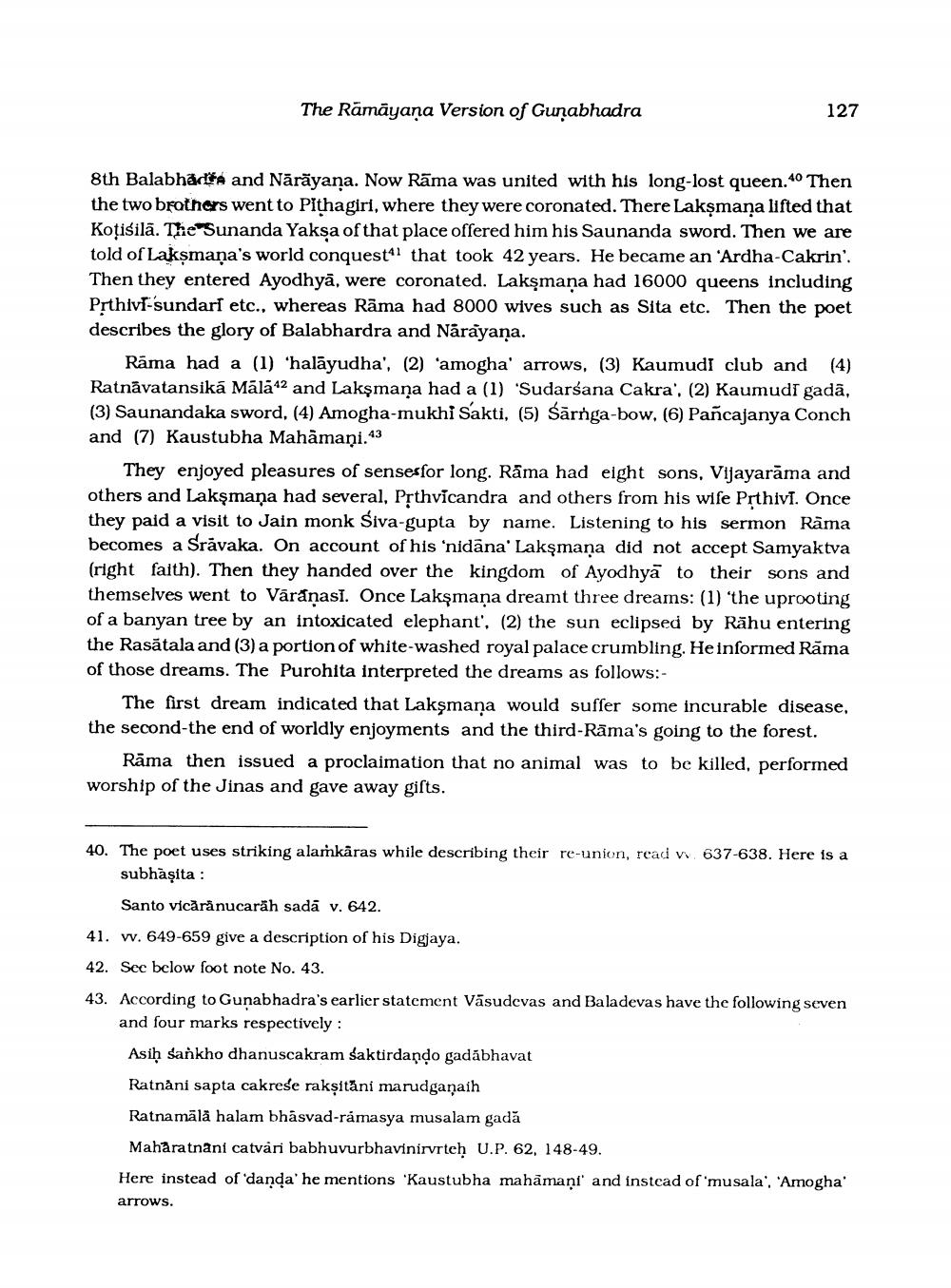________________
The Rāmāyaṇa Version of Gunabhadra
8th Balabhad
and Nārāyaṇa. Now Rama was united with his long-lost queen.40 Then the two brothers went to Pithagiri, where they were coronated. There Lakṣmaṇa lifted that Kotisila. The Sunanda Yakṣa of that place offered him his Saunanda sword. Then we are told of Lakṣmaṇa's world conquest that took 42 years. He became an 'Ardha-Cakrin". Then they entered Ayodhya, were coronated. Lakşmana had 16000 queens including Prthivi-sundari etc., whereas Rama had 8000 wives such as Sita etc. Then the poet describes the glory of Balabhardra and Narayana.
127
Rāma had a (1) 'halayudha', (2) 'amogha' arrows, (3) Kaumudi club and (4) Ratnavatansikā Mālā12 and Lakṣmaṇa had a (1) 'Sudarśana Cakra', (2) Kaumudi gadā, (3) Saunandaka sword, (4) Amogha-mukhi Sakti, (5) Śarnga-bow, (6) Pañcajanya Conch and (7) Kaustubha Mahamani."
They enjoyed pleasures of sense for long. Rama had eight sons, Vijayarāma and others and Lakṣmaṇa had several. Pṛthvicandra and others from his wife Prthivi. Once they paid a visit to Jain monk Śiva-gupta by name. Listening to his sermon Rama becomes a Srávaka. On account of his 'nidāna' Lakṣmaṇa did not accept Samyaktva (right faith). Then they handed over the kingdom of Ayodhya to their sons and themselves went to Varanasi. Once Lakşmana dreamt three dreams: (1) the uprooting of a banyan tree by an intoxicated elephant', (2) the sun eclipsed by Rähu entering the Rasatala and (3) a portion of white-washed royal palace crumbling. He informed Räma of those dreams. The Purohita interpreted the dreams as follows:
The first dream indicated that Laksmana would suffer some incurable disease, the second-the end of worldly enjoyments and the third-Rama's going to the forest.
Rāma then issued a proclaimation that no animal was to be killed, performed worship of the Jinas and gave away gifts.
40. The poet uses striking alamkaras while describing their re-union, read v. 637-638. Here is a subhasita:
Santo vicărănucarah sadā v. 642.
41. v. 649-659 give a description of his Digjaya.
42. See below foot note No. 43.
43. According to Gunabhadra's earlier statement Vasudevas and Baladevas have the following seven and four marks respectively :
Asiḥ sankho dhanuscakram saktirdando gadabhavat
Ratnani sapta cakrese rakṣitāni marudganaih
Ratnamälä halam bhāsvad-ramasya musalam gadă
Maharatnani catvari babhuvurbhavinirvrteḥ U.P. 62, 148-49.
Here instead of 'danda' he mentions 'Kaustubha mahamani' and instead of 'musala', 'Amogha'
arrows.




